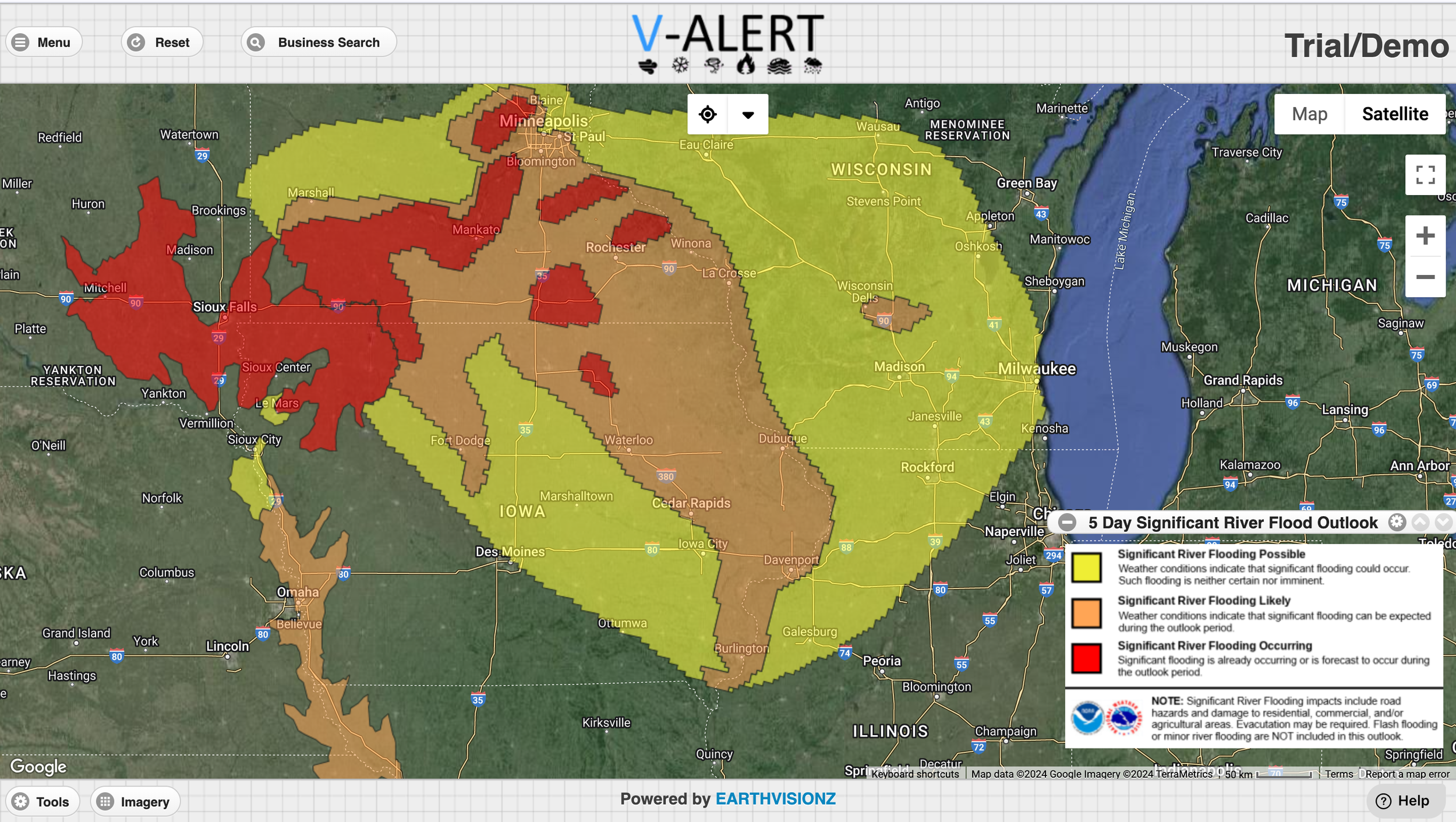Earthvisionz Insights: Heavy Rainfall Triggers Widespread Flooding Across the Midwest
The 5 day significant river flood outlook helps Earthvisionz users understand how river floods will affect surrounding areas.
The Event
Hundreds of Iowa residents have been rescued from severe flooding caused by record-setting torrential rains that have impacted the Midwest, including parts of South Dakota, Nebraska, and Minnesota. The flooding has submerged buildings, shut down major roads, and disrupted essential services like electricity and drinking water. Iowa Gov. Kim Reynolds noted that water levels in some areas have surpassed the infamous 1993 floods.
The flooding has been exacerbated by continuous heavy rainfall, with South Dakota and Iowa experiencing significant downpours. Wet soil conditions have prevented further absorption, leading to rapid river rises and significant damage, including the collapse of a train bridge and concerns over the potential failure of the Rapidan Dam in Minnesota.
The 7-day observed precipitation layer allows Earthvisionz users to see cumulative rainfall, aiding in understanding which areas are most likely to experience flooding.
Crests, the highest points rivers reach before receding, are being closely monitored as rivers have risen quickly. The Big Sioux River stabilized at an unprecedented 45 feet, while other rivers like the James and Vermillion are expected to crest soon, potentially increasing levels in the Missouri River.
This extreme weather is part of a broader trend of increasing climate extremes, as a warmer atmosphere holds more water, leading to heavier rainstorms and more frequent severe flooding.
Flood Mapping and Damage Assessment
US Flood Gauge Observation and US Flood Alerts Layer
Flood mapping is a valuable tool when it comes to damage assessment. Earthvisionz gives you the ability to combine multiple sources of information to help you understand the event. For example, during a flood event, you can compare the US Flood Gauge Observation Layer with the US Flood Alerts Layer to obtain an accurate idea of the extent of the flood in an area. When you click on one of the flood gauge icons, you will get information such as flood level and a link to a hydrograph.
What Is A Crest?
A crest in a river refers to the highest level the water reaches before it starts to recede. These crests are closely monitored by forecasters because they indicate the peak of flooding, helping to predict its severity and downstream impact.
Recent heavy rains have caused rivers in the region to rise rapidly, resulting in or expected to result in crests soon. For instance, the Big Sioux River stabilized at a record-breaking 45 feet in Sioux City. The unpredictability of such high water levels makes forecasting challenging, especially when historical data is insufficient.
South Dakota Governor Kristi Noem noted that other rivers like the James and Vermillion are expected to crest on Wednesday, June 26th, albeit at lower levels than initially feared due to the spread-out nature of flooding. This has allowed time for communities to prepare and make the necessary levee upgrades.
Further rain in northeastern Iowa is expected to exacerbate the situation, prolonging the flooding as water drains through the state's river systems towards the Missouri and Mississippi rivers. Consequently, flooding is anticipated in these major river systems as well.
Clicking on the hydrograph link will take you to the NOAA website where you can see detailed information on the flood stage and forecast at that exact point.
Flood Mitigation
Midwesterners have been actively working on flood mitigation since the establishment of the Soap Creek Watershed by local landowners in 1986. This watershed was the first formally recognized watershed board in Iowa, initiated to address local flooding concerns. By 1988, they identified 154 farm ponds and water detention structures to mitigate flooding. With support from the Iowa Watershed project, over 130 of these projects were completed, resulting in a 43% reduction in streamflow during a 100-year storm event due to strategically placed farm ponds. The program also encouraged local governments to develop their own flood reduction and water-quality improvement strategies. For example, Fayette County in Northeast Iowa implemented on-road water retention structures using roadway embankments as dams for temporary flood storage during heavy rainfall, which proved to be more sustainable and cost-effective than traditional culverts.
A 2010 FEMA study of nine Iowa Flood Reduction Projects found that these initiatives avoided $52,863,381 (in 2010 dollars) in total losses, which is about 18x the initial investment in the projects. This substantial ROI underscores the economic viability of flood mitigation efforts.
Furthermore, the Iowa Watershed Approach (IWA), active from 2008 to 2022, successfully reduced flooding up to 20%. The IWA focused on constructing natural infrastructure projects and developing local watershed management authorities, which played a crucial role in improving water retention and reducing runoff.
These examples demonstrate that with careful planning, effective flood mitigation is achievable. The success stories from the Soap Creek Watershed and the Iowa Watershed Approach highlight the importance of strategic, community-driven efforts in managing flood risks and protecting local economies from the devastating impacts of flooding.
Update: June 28th
As of Friday morning (June 28th), the Missouri River is expected to crest on Saturday morning in the Omaha area due to runoff from several days of heavy rain upstream.
The National Weather Service predicts moderate to near major flood stages along the Missouri River from Blair to Rulo this week, similar to the flood levels last seen in 2019.
Key points:
- Decatur: Crested at 37.55 feet early Wednesday; minor flooding forecast for Friday.
- Blair: Crested at 32.15 feet Thursday; moderate flooding expected into the weekend.
- Omaha: Expected to crest at 33.1 feet Saturday; significant flooding anticipated in NP Dodge Park, Tom Hanafan Park, Fontenelle Forest, and low-lying roads.
- Plattsmouth: Expected to crest at 32.2 feet Sunday; closures of Interstate 29, Highway 34, and other roads anticipated, with potential home flooding.
- Nebraska City: Expected to crest at 23.8 feet Sunday; critical facilities may be affected.
- Brownville: Expected to crest at 40.6 feet Monday; potential levee overtopping.
- Rulo: Expected to crest at 23.5 feet Tuesday.
Flooding will impact major roads, homes, industrial companies, parks, and wildlife refuges along the river.






